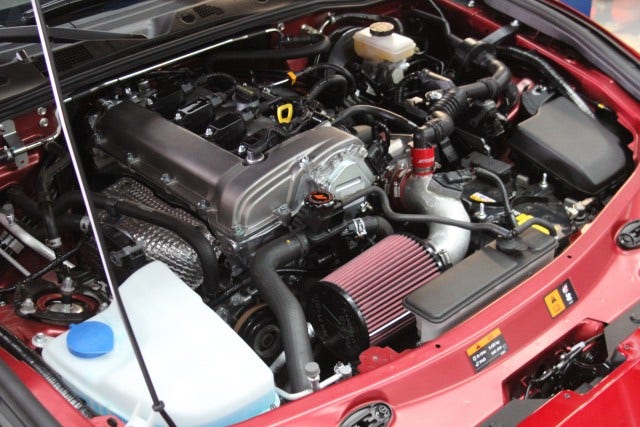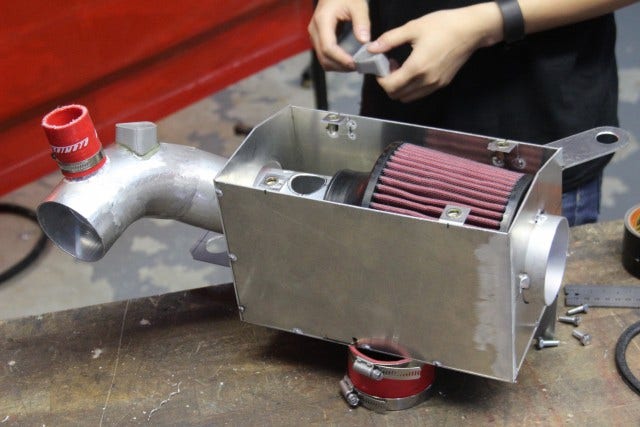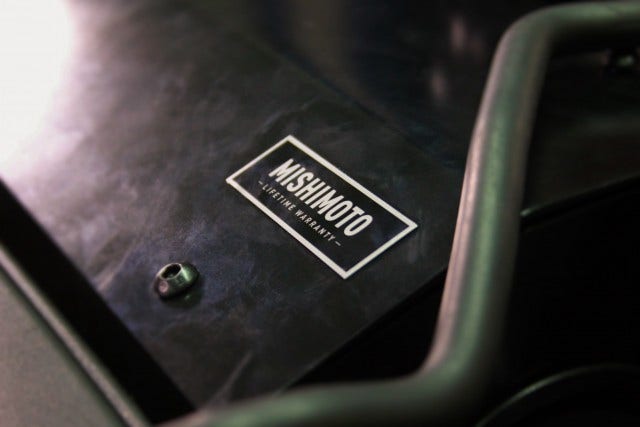
Testing and Results - ND Miata Intake, Part 4
We finally have an update for the Miata intake project!
With our prototype now in working order, we were finally able to hook up our ND Miata to our dynamometer and get some pulls underway. At this point in the process, we knew we'd want to play around with some other design ideas while the car was hooked up to the Dynapack. AFRs, power output, and sound clips were all on the agenda for the evaluation of this prototype system.
Results

Miata intake dynamometer results results
We did gain some decent performance in the low end of the power band, but the upper end of the curve follows the path of the stock intake system. This graph displays an average of several pulls to ensure that each setup produced a consistent output and plot.
During our testing with the BRZ performance intake, we found a noticeable improvement in power output when we removed the sound tube. We did runs for the ND both with and without the sound tube and found no difference in performance. The effect of sound tubes on performance will always depend on the vehicle, and in the ND's case it was a non-factor. We will, however, still offer the option to remove the sound tube.
Weighing Our Options
To bring you the best intake possible, we experimented with a few different filter types and pipe designs to see how they would perform.
First, we tried to see if enlarging the filter would make an impact on output, the thought being that perhaps airflow was being limited by our filter size, airbox restriction, or both. We also removed the airbox and ran a few runs with the filter alone. The filter shown has a velocity stack built into it (a feature in all our intake filters) to help with airflow, but results were similar to those of previous tests. Without the airbox and use of the front scoop, our plots showed a slight loss in power.

Miata intake prototype

Miata intake prototype
Then we tried to see what we could do to improve our intake pipe design. Our engineers were curious about the resonator attached directly along the airflow routing. So, our team measured the volume of the stock resonator and modeled our prototype with a similarly sized orifice to determine the impact on output. Check out some shots below.

Miata intake prototype
The addition of the resonator deadened intake sound a bit, but output remained the same.

Miata intake prototype with our own resonator attached

Miata intake prototype with our resonator attached
After all those designs, redesigns, additions, and removals, we took a step back to think and analyze. What can we do to further improve what we have? We knew that the mass airflow (MAF) sensor placement might spook some consumers due to its location near the curved part of the pipe. Moving it to where it will read straighter airflow can only help, so that's exactly where we began to direct our focus.

Engineers going through design options
As you can see below, using a slightly different filter, we can access a perfectly straight part of the airflow. This was the optimal location if we wanted to try a different placement for the MAF sensor.

Miata air intake prototype
With the MAF sensor placed away from any bends in the system, we could see more laminar airflow, which would give us more accurate and consistent airflow readings. We had to fabricate an extra piece to attach to the existing pipe for the MAF housing and print out another MAF adapter.

Constructing the newly modified Miata intake
With our ideas implemented, we made some revisions to the pipe and finished another prototype. Here is what our newest pipe design will look like!

CMM Modeling
Before the wheels started turning on production, we wanted to try one final performance test on this intake to see how gains could be made solely on this upgrade. A tune! We sent this prototype Miata intake unit to the awesome folks at OrangeVirus Tuning (OVT) where they tested it on an ND Miata (courtesy of Goodwin Racing) at their shop to test it on. As I'm sure most of you know, OVT is well known in the Mazda community for their tuning capabilities, and we were happy to work with them on this project.
The tune for this Miata intake resulted in negligible power gains, but there is good news!
Our placement of the MAF sensor resulted in smoother airflow readings within the mid-range and at higher RPMs. The stock intake had a lot of inconsistent, oscillating airflow in the high-RPM power band, but we were able to level that out, making readings a bit more predictable. Check out an image from OVT!

Data from OVT
The graph you're reading shows grams of air per second passing through the sensor. As you can see, our readings are much flatter compared to the stock intake, which has a rocky curve. It turns out relocating our MAF to a straighter portion of the pipe was quite effective. Our system happened to be slightly smoother in the very early curve as well. It turns out relocating our MAF sensor to a straighter portion of the pip proved effective.
OrangeVirus wasn't quite done with putting our prototype through their rigorous testing. Another ND Miata at the OVT shop had upgraded headers and exhaust. The protoype intake was installed in the car to see how it would react. Although the numbers still were the same, that is actually more good news, because it further verifies that our intake is not causing any restrictions. According to the results, there most likely won't be any improvements on engine airflow, regardless of the kind of aftermarket bolt-on installed on the car. Our tuners concluded that the airflow of the engine would max out before this intake becomes a restriction on the system.
So why would you want to put this intake on your ND Miata?
More Stable Airflow
This intake keeps the incoming air more steady and level compared to the stock unit, reducing the amount of turbulence otherwise evident in the stock system. The result is torque and power output curves that are a bit more stable and efficient. With smoother airflow going into the engine, less fuel is wasted during combustion process.
Non-restrictive
Our intake will maximize the amount of airflow coming into your engine. With better airflow stability, there isn't much room for more improvement. When designing an aftermarket intake, the goal is to always reduce the amount of airflow restriction, and we've done that well with our design.
Aesthetics
Considering the location of the intake, appearance is an important factor. We wanted to ensure that this system would be pleasing to look at when the hood is opened, since it's one of the first things you see. Our design is clean, unique, and will grab the attention of anyone looking at the engine bay.
What's Next?
That was a lot to digest! Although the prototype isn't finished yet, a quick teaser won't hurt!

Finished Miata intake prototype
We are in the final stages of revealing the last iteration of our prototype now that our product testing is done. We still need to confirm fitment before we give the go-ahead to send this design into full-scale production. Our next update will come very soon.
We are interested in your thoughts and comments, so feel free to send them our way!
-Diamaan












